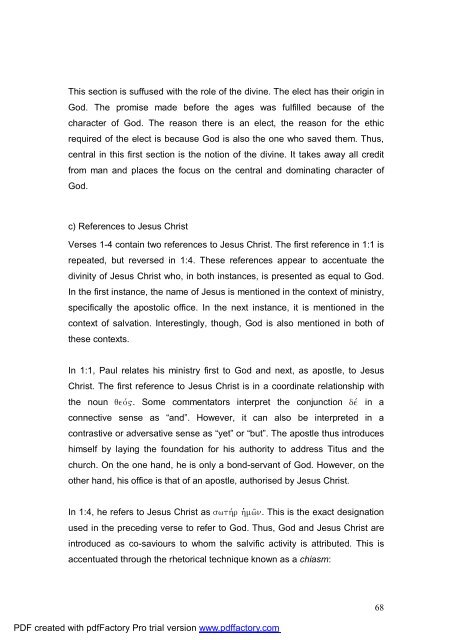A Text centred rhetorical analysis of Paul's Letter to Titus
A Text centred rhetorical analysis of Paul's Letter to Titus
A Text centred rhetorical analysis of Paul's Letter to Titus
Create successful ePaper yourself
Turn your PDF publications into a flip-book with our unique Google optimized e-Paper software.
This section is suffused with the role <strong>of</strong> the divine. The elect has their origin in<br />
God. The promise made before the ages was fulfilled because <strong>of</strong> the<br />
character <strong>of</strong> God. The reason there is an elect, the reason for the ethic<br />
required <strong>of</strong> the elect is because God is also the one who saved them. Thus,<br />
central in this first section is the notion <strong>of</strong> the divine. It takes away all credit<br />
from man and places the focus on the central and dominating character <strong>of</strong><br />
God.<br />
c) References <strong>to</strong> Jesus Christ<br />
Verses 1-4 contain two references <strong>to</strong> Jesus Christ. The first reference in 1:1 is<br />
repeated, but reversed in 1:4. These references appear <strong>to</strong> accentuate the<br />
divinity <strong>of</strong> Jesus Christ who, in both instances, is presented as equal <strong>to</strong> God.<br />
In the first instance, the name <strong>of</strong> Jesus is mentioned in the context <strong>of</strong> ministry,<br />
specifically the apos<strong>to</strong>lic <strong>of</strong>fice. In the next instance, it is mentioned in the<br />
context <strong>of</strong> salvation. Interestingly, though, God is also mentioned in both <strong>of</strong><br />
these contexts.<br />
In 1:1, Paul relates his ministry first <strong>to</strong> God and next, as apostle, <strong>to</strong> Jesus<br />
Christ. The first reference <strong>to</strong> Jesus Christ is in a coordinate relationship with<br />
the noun qeov~. Some commenta<strong>to</strong>rs interpret the conjunction dev in a<br />
connective sense as “and”. However, it can also be interpreted in a<br />
contrastive or adversative sense as “yet” or “but”. The apostle thus introduces<br />
himself by laying the foundation for his authority <strong>to</strong> address <strong>Titus</strong> and the<br />
church. On the one hand, he is only a bond-servant <strong>of</strong> God. However, on the<br />
other hand, his <strong>of</strong>fice is that <strong>of</strong> an apostle, authorised by Jesus Christ.<br />
In 1:4, he refers <strong>to</strong> Jesus Christ as swthvr hJmw`n. This is the exact designation<br />
used in the preceding verse <strong>to</strong> refer <strong>to</strong> God. Thus, God and Jesus Christ are<br />
introduced as co-saviours <strong>to</strong> whom the salvific activity is attributed. This is<br />
accentuated through the <strong>rhe<strong>to</strong>rical</strong> technique known as a chiasm:<br />
PDF created with pdfFac<strong>to</strong>ry Pro trial version www.pdffac<strong>to</strong>ry.com<br />
68

















